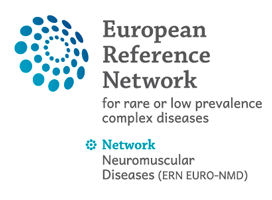Delivered by: Sabrina Sacconi and Gabriele Siciliano
Telemedicine in NMD: state of the art
Sabrina SACCONI is Professor of Neurology at Nice University Hospital (France), now recognized as Reference Center for rare Diseases.
Pr. SACCONI starts to practice medicine in 1997 at Pavia in Italy and becomes specialist in neurology in 2003. From 2004 to 2008, she begins a European career and constantly improves her competences and understandings on neuromuscular disorder. In 2010, she obtains a PhD in cell physiology and biology with a work on genetic and epigenetic of facioscapulohumeral muscular dystrophy. In 2012, she obtains an accreditation to supervise research in Nice and becomes full University Professor in 2014 for the Nice UHC.
Since then, she is Head of the department « Peripheral Nervous System and Muscle ». She is also coordinating a basic research team at IRCAN Institute of Research on Cancer and Aging and working on the suppling of several databases and biobank on rare neuromuscular diseases.The main research topic of Prof. Sacconi is the development of new therapeutic strategies on neuromuscular diseases based on the understanding the role of genetic, epigenetic, endocrine and immune system deregulation in the progression of these diseases.
Gabriele SICILIANO
Present position: Full Professor in Neurology, Department of Clinical and ExperimentalrnMedicine, University of Pisa. President of Italian Association of Myology (AIM), since 2015 to date.
Academics and Professionals: Degree in Medicine: University of Pisa,l 27/6/1980, cum laude.rnSpecialization in Neurology: University of Pisa, 15/11/1984, cum laude, Thesis: “Methods of clinical evaluation of motor function in Duchenne Muscular Dystrophy”. Specialization in Physical and Rehabilitation Medicine: University of Pisa, 21/7/1992, Thesis: “Muscle metabolic aspects of fatigue in normals as evaluated by means of Phosphorus31 Spectroscopic Nuclear Magnetic Resonance during submaximal contraction”;. PhD in Neurological and Neurosensorial Sciences (University of Ancona, 2/10/1990), Thesis: “Central and peripheral mechanisms of muscle fatigue in normals and in neuromuscular diseases”. Post-Doctoral Research in Neurosciences: University of Ancona, from 16/9/1991 to 15/9/1993. Neurologist Assistant Register: at Neurological Clinic, University of Pisa, from 1993 to 1997. University Researcher Department of Neuroscience, University of Pisa from 1997 to 2001. University Associated Professor in Neurology (MED/26). Department of Clinical and Experimental Medicine, University of Pisa from 2001 to 2015. Research activities and interests: Since 1993 he is responsible for the Unit of Neuromuscular Diseases and for the Laboratory of Molecular Diagnosis in the former Department of Neuroscience, now Department of Clinical and Experimental Medicine – Neurological Clinics – University of Pisa, with main interests in clinical, laboratory and molecular aspects of neurodegenerative and neurogenetic disorders, acquired and genetic diseases of peripheral nervous system and skeletal muscle. These activities are conducted in collaboration with some overseas centres and laboratories. Since 1986 he has been engaged in studies on muscular dystrophies, metabolic diseases of muscle and motorneuron diseases. In particular,he has studied several issues on muscle fatigue, in collaboration with the Muscle Research Centre, University of Liverpool (Prof. RHT Edwards), exercise in normal and myopathic subjects, motorneuron output evaluation in amyotrophic lateral sclerosis, subsarcolemmal excitability in myotonic syndromes and muscular dystrophies, analysis of metabolic parameters in McArdle’s disease and mitochondrial myopathies. In the same period he has been engaged in epidemiological and therapeutical studies on neuromuscular disorders, in particular the use of selenium in Steinert disease, idebenone in mitochondrial myopathies, mexiletine in congenital myotonia, TRH and riluzole in amyotrophic lateral sclerosis. As far as mitochondrial myopathies are concerned, he is currently studying the effects of aerobic training programs, the relationship between metabolic and catecholaminergic systems during exercise, the pathogenic role of mitochondrial transcription factors, the diagnostic usefulness of magnetic resonance spectroscopic techniques. Furthermore, he is working on the possible role of mitochondrial involvement and oxidative stress in the pathogenesis of neurodegenerative disorders. All these activities have led to a scientific production volume represented by near 300 full papers, in specialized cited international journals, dealing with the above indicated arguments, funded projects from Institutional and Charity bodies, responsibility in research evaluation committees for public and private funding research bodies, participation to national and international clinical trials performed according to GCP (last GCP training certificate obtained in 19 February 2016).
He has been the Coordinator of the nation−wide Italian collaborative network established in 2009 (granted by Telethon-UILMD GUP09004), that has already developed a web-based registry of patients with mitochondrial diseases. They have collected 1400 patients, with onset of the disease in both adulthood and in childhood.

